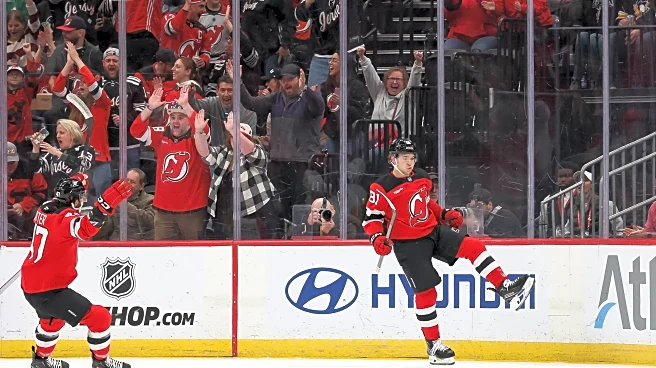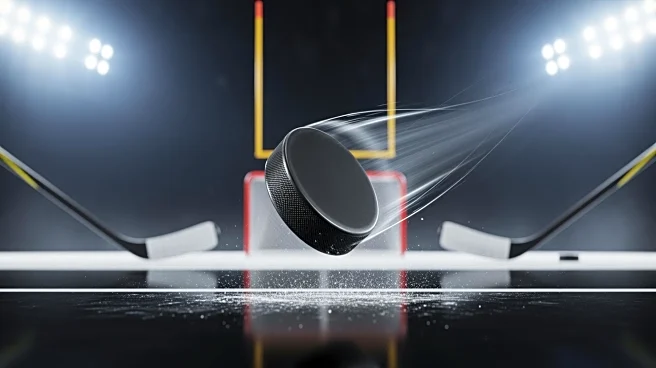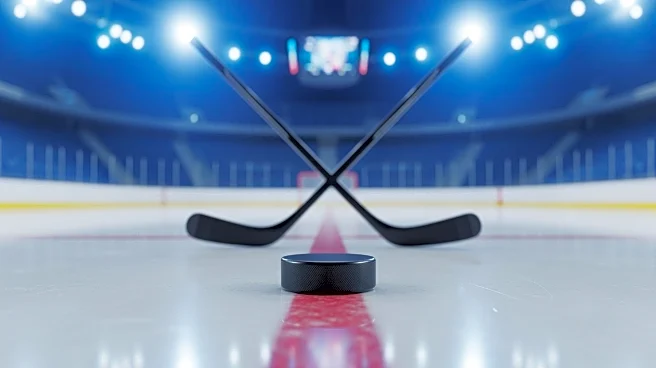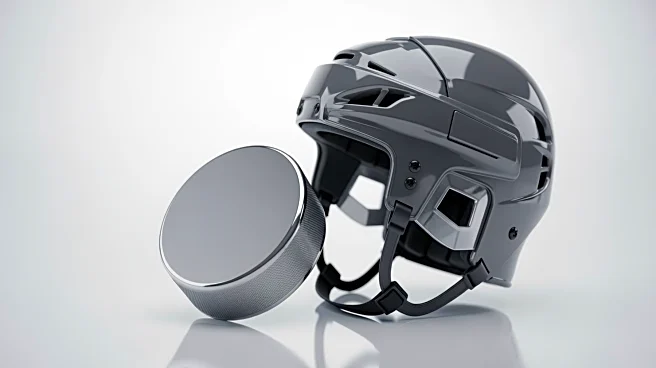Take a look at the NHL Standings page. You will notice that the New Jersey Devils begin the week tied atop the Eastern Conference with 22 points. At 11-4-0, the Devils have begun their season about as well
as any of us could have possibly imagined. We all looked at how brutally difficult their early schedule was on paper and dreaded this team getting buried in the standings right out of the gate. Instead, New Jersey ripped off an early eight-game winning streak to propel them to the best record in the East here in the second week of November. Couple that with the fact that they’re currently riding a two-game winning streak and are a perfect 7-0-0 at home, and things are going well.
There is a problem that has begun to emerge, however: The Devils have generally been getting outplayed most nights.
Over the past two weeks, New Jersey has won four of their seven games played. Not world-beating stuff, but certainly good enough over a couple-week stretch. The problem is, it is easy to make the case that the Devils were lucky to even collect those modest results. Points are points, and you don’t have to give them back, but if New Jersey wants to keep collecting points, it would behoove them to find their game again.
Today we’ll take a closer look at New Jersey’s performances over the past two weeks, why the process does not match the results, why it matters, and what can be done about it.
Let’s begin.
Why Complain?
First, let’s address why process not matching results can matter in the first place.
Year after year in the analytics era, we have seen that the best predictor of results is a good underlying process. Winning the shots battle, Expected Goals For battle, and various other analytics battles generally leads to a rise up the standings page. Sure there is a team or two every year that gets to the playoffs despite poor underlying numbers. They usually ride good shooting luck and/or terrific goaltending to the postseason. But they are the exceptions, not the rule, and even if a team is lucky enough to make it past the regular season with a poor analytics profile, they almost never make it all that far in the dance.
In the Devils’ case, no one is saying they should feel guilty about getting wins despite getting outplayed. And no one is saying they can’t start winning the analytics battle going forward. But why this matters is that the way New Jersey has been winning lately is usually unsustainable. They might be able to count on consistently good goaltending from Jacob Markstrom and Jake Allen this season, but we’ve already seen both goalies put up multiple clunkers through 15 games, so I wouldn’t count on season-long stellar play.
Meanwhile the Devils are shooting 11.92% as a team. For context, that would have been good for 3rd-best in the league in both 2024-25 and 2023-24, 1st in the league in 2022-23, and 2nd in the league in 2021-22. Granted they are only 8th in the league right now, but you can attribute that to early-season small sample noise. Once we get deeper in the campaign, shooting percentages should level out. But as you can see, since the Covid-shortened seasons, the Devils are shooting at a rate that would put them in outlier territory. Some teams can replicate shooting performances like that year after year, but New Jersey does not have the proven snipers up and down their roster that would give us confidence they can sustain this. The good shooting luck will end, maybe beginning with tonight. So when that happens, the Devils need to start winning the puck possession battle again.
So What Do The Numbers Actually Say?
Now that we’ve discussed why it matters to talk about poor process even if the results are good, the next question would be…is the process actually poor? After all, New Jersey continues to rack up wins, so how bad could their performances possibly be? To answer this question, we’ll take a look at a couple different analytics outlets. Before we do, I feel compelled to give all the usual caveats, though:
I believe in public analytics, but no individual model is the be-all end-all. Each has their own limitations that need to be taken into account. That said, public models can be a very useful tool when trying to evaluate a team, and even if they’re limited, they capture a lot of things the traditional box score or one’s personal eye test often miss.
So with all that in mind, let’s start with Natural Stat Trick. Over the last two weeks, NST has not been impressed with the performance of New Jersey’s skaters:
According to Natural Stat Trick, the Devils lost in the run of play in six of their last seven games. They’ve only had one truly dismal game though, the 11/01 game in Los Angeles, ironically a win. Still, six of seven losses is six of seven losses.
Next, let’s take a look at Moneypuck’s infamous “Deserve To Win O’Meter” for each game during this stretch:
Moneypuck is a tiny bit more complimentary to New Jersey, giving them two analytical “wins” instead of one. But only winning the puck possession battle in two of seven contests is still nothing to brag about.
Again, these are only two models, and each has their limitations. But at the same time, Natural Stat Trick and Moneypuck are two of the more well-known, well-respected analytics models in the public sphere. Even if you don’t 100% agree with their numbers (and I’m one of those people who does not believe everything they put out), they are both worth paying attention to. And what they’re saying is that the Devils have been getting thoroughly outplayed over the past couple of weeks.
The Obvious Extenuating Circumstances
Ok so there is a very important detail that needs to be mentioned when it comes to the Devils not looking so sharp over their most recent two weeks of action:
The absurd amount of injuries.
New Jersey has not enjoyed the services of Evgenii Dadonov since opening day. Brett Pesce got hurt in the first game against the Avalanche and we haven’t seen him since. Cody Glass only recently came back from a seven-game injury absence of his own, returning for the Montreal game. Dougie Hamilton suffered an injury against the Canadiens, missed the second half of that contest, and did not suit up against Pittsburgh. Not to mention the continued absence of Johnny Kovacevic.
Needless to say, this is a ridiculous amount of injuries for a team to endure.
Thus far, the Pesce injury appears to be the most impactful one. New Jersey was keeping its collective head above water defensively with Pesce in the lineup, but once he hit the shelf the defense started to crater. It would be nice if New Jersey’s defense wasn’t reliant on a single player, but you have to assume that as more time goes on, the Devils will learn to play without Pesce. Not to mention that his injury is not believed to be season-ending, so we will see him again at some point.
But the rest of the injuries have been impactful as well, even if New Jersey has been fortunate enough to avoid injury to most of their key players. But even if the injured players aren’t the inner-circle core of this team, they are still important players. And additionally, when starting-caliber players go down, you have to replace them with by-definition non-starting caliber players. That might be acceptable if you only have to dig one or two players deep into your depth. But once you reach five or six players down, it gets to a point where a team just cannot overcome the injuries. Case in point, On Saturday the Devils had to play Dennis Cholowski and Colton White on defense. Head coach Sheldon Keefe clearly had no trust in either player, giving White a mere 9:55 of ice time, and Cholowski only 13:15. And it’s not like they lit it up in their minutes either, with White producing a 5-on-5 xGF% of 31.78, and Cholowski coming in even worse at 19.90. The Devils coaching staff sheltered White and Cholowski as much as they possibly could, and they still got run over by their competition.
You have to figure that New Jersey will look a lot better once they are at full health (if that day ever comes).
The other factor to mention is that this stretch has featured tough competition and a west coast road trip, which is never easy. Yes the California teams aren’t supposed to be particularly good, but the Sharks have been a lot better since losing their first six games of their season, and the Ducks are shockingly second overall in the league in points. Meanwhile the Kings are still solid, and the Avalanche are arguably the best team in the league thus far. Add in games against a good Montreal team and a Penguins team that is bewilderingly high up the standings, and the schedule has not done New Jersey any favors over the last two weeks. We talked about how the very start of the season looked tough on paper, but the tough slate of games really has continued well into November.
So in the end, losing the run of play against mostly quality teams while suffering a raft of injuries is not the end of the world. You’d prefer to see the Devils dominate puck possession of course, but given the circumstances, things could be worse.
Final Thoughts and Your Take
So in the end, the Devils continue to rack up wins despite usually not being the better team by the end of the night. As mentioned, you have to be happy with all the points they’ve banked despite the injuries and the harrowing schedule. In fact, one might look at the results and credit the Devils for “finding ways to win”. I have to admit, I’m not one of those people. I don’t exactly believe New Jersey is finding ways to win, I think it more comes down to the team having a fair bit of good luck on their side lately. That luck won’t last forever, and when the Devils finally start rolling snake eyes, it would help if they could replace their good luck with good process.
So be happy with the points they’ve banked, and be compassionate given the injuries and schedule. But understand that there is a very real possibility that New Jersey will start losing a lot of games if they don’t get their act together as far as the process goes. We all know they have what it takes to start winning the puck possession battle. Now they have to show it before the wins dry up.
What do you think of the Devils’ play lately? Do you think I’m being too hard on them, or do you agree with what the metrics say? Do you think a simple return to full health at a team level will remedy this, or is there something deeper going on? As always, thanks for reading!













